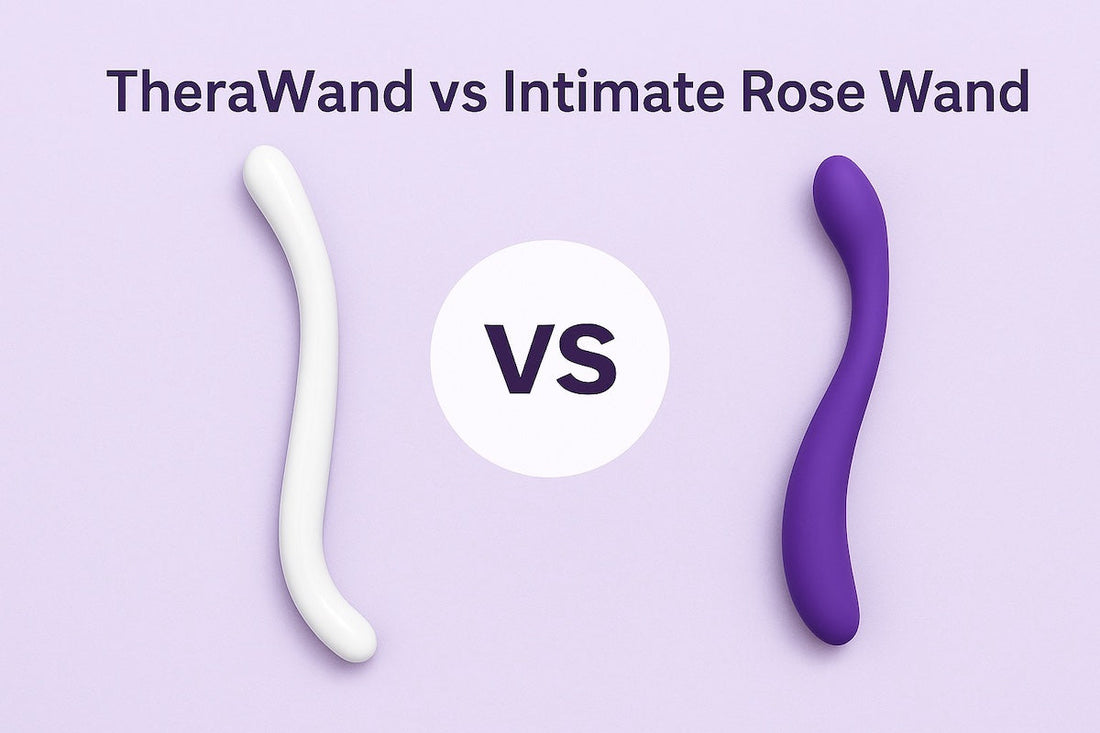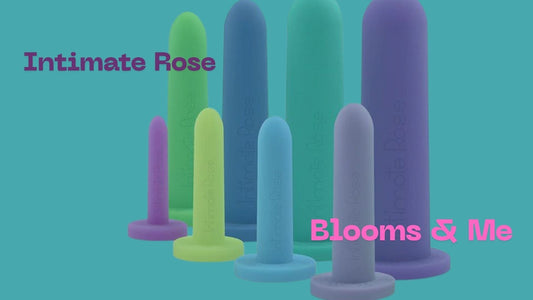TheraWand and Intimate Rose Pelvic Wand are both pelvic health tools designed to massage hard-to-reach pelvic muscles, release pain and tightness, and improve pelvic floor dysfunction. Widely recommended by physical therapists for at-home treatment of dyspareunia, endometriosis, and vaginismus, pelvic wands can help improve quality of life by restoring pelvic health and enhancing sexual function.
Although both are designed to support pelvic physical therapy, TheraWand and Intimate Rose Wand differ in design, manufacturing material, price, and features. Discover the differences and similarities below, before deciding which is best for you.
What Are Pelvic Wands?
Pelvic wands are therapeutic tools regularly recommended for patient home use by pelvic physical therapists to massage and relax tight pelvic floor muscles, ease painful muscle trigger points, relieve pelvic pain, improve pelvic floor dysfunction, and re-establish sexual pleasure.
Due to their ease of use, pelvic massage wands are also highly recommended for pelvic care at home, where patients can continue the manual therapy started by their pelvic physical therapist.
While pelvic wand shapes can differ, most are shaped like the letter S or U to provide easier access to the pelvic floor. To reach all the pelvic floor muscles, many pelvic wands are also dual ended for either vaginal or rectal insertion. Therefore, initial guidance from a pelvic physical therapist is advised to relieve pelvic floor dysfunction correctly.
Why Use Pelvic Wands?
To support urination, defecation, posture, and pleasure during sex, the pelvic floor muscles must contract and relax when required. In some cases, however, the pelvic floor muscles can become tense to the point that they cannot fully relax.
Known as a hypertonic pelvic floor (tight or overactive pelvic floor muscles), this condition can cause issues with the bladder or bowel, pain during sex, spasming pelvic or vaginal muscles, and ongoing pelvic pain.
Tight pelvic floor muscles also restrict blood flow and reduce muscle oxygenation in the pelvic area, which, in addition to chronic pelvic pain, can manifest as tightness in the glutes, hip flexors, and hamstrings.
Fortunately, regular pelvic therapy with a pelvic wand approved by your physical therapist can help relax hard-to-reach pelvic floor muscles, release deep-rooted trigger points, improve blood flow, and increase muscle oxygenation. Relieving a hypertonic pelvic floor and re-training the pelvic muscles to contract and relax when required also eases bladder or bowel issues and enhances sexual pleasure.
The TheraWand vs Intimate Rose Pelvic Wand: How Do They Differ?
TheraWands and Intimate Rose Pelvic Wands differ in several ways.
Material
The first difference lies in the manufacturing material used. TheraWands are made from medical-grade acrylic, while the Intimate Rose Wand is the pioneer of pelvic tools made with safer and more comfortable medical-grade silicone.
Medical-grade silicone is considered safer than medical-grade acrylic for internal use due to its ability to repel water (hydrophobicity), which helps prevent harmful bacteria from adhering to the wand's surface. This is a crucial feature when using pelvic health tools to avoid vaginal infections.
Although both materials are BPA-free, medical-grade silicone is considered more biocompatible with human tissue and reduces the risk of skin irritation or allergic reactions compared to acrylic. Comfort levels, according to users, are also higher with medical-grade silicone, which feels much softer and smoother in the vaginal or anal canal.
Design
The Intimate Rose Pelvic Wands are 100% designed by Dr. Amanda Olson, a pelvic physical therapist with years of experience treating female pelvic health. The design reflects the anatomy of the pelvic bowl and ensures that the wand can properly reach the deeper and harder to access muscles of the pelvic floor.
The outcome is that Intimate Rose Pelvic Wands are undoubtedly the superior product with a more pronounced curvature and a length of 9.5 inches compared to the TheraWand's 8 or 8.5 inches.
In our experience, the longer and thinner end of Intimate Rose Pelvic Wands are expertly designed to reach the deepest muscles of the pelvic floor (including the obturator internus), and the shorter, slightly thicker end is perfect to relax superficial muscles closer to the entrance of the vaginal and anal canals.
For some patients, the deepest pelvic floor muscles can be more difficult to reach with the shorter length of the TheraWand.
Features
TheraWand offers two pelvic wand options: the LA-Wand and the V-Wand.
The V-Wand is dual-ended, with a thicker end for superficial muscle massage and a thinner end for more precise trigger point release. The LA-Wand, on the other hand, provides a thin, tapered end and a wave or bauble-like end that can be used as a handle or for relaxing a wider surface area of superficial muscles.
TheraWands come with a storage bag and an instruction leaflet.
When pelvic physical therapists and their patients globally embraced the expert design and silky-smooth feel of the medical-grade silicone used in the original Intimate Rose Pelvic Wand (colored purple), it was no surprise that other options followed with added benefits.
The Temperature Therapy Pelvic Wand from Intimate Rose, colored yellow in support of endometriosis sufferers, has the same original design features with the added option of hot and cold therapy. The wand's temperature-retaining core can be cooled to reduce inflammation & pain or warmed to improve blood flow & relax muscle tension.
The same design features are incorporated into the Intimate Rose Vibrating Pelvic Wands (colored blue or green), which offer 10 soothing vibration settings for improved blood circulation and reduced pain in the pelvic floor.
The Bendable Pelvic Wand from Intimate Rose (colored orange) is designed for a longer reach and deeper relief. With its customizable shape and length of 17 inches, its extended reach is ideal for individuals with limited mobility, who are pregnant, or overweight.
Intimate Rose Wands come with a velvet storage bag, instructions, and access to online support and pelvic wand video tutorials by Dr. Olson.
Price
TheraWands are priced between $59 and $79, depending on the retailer. The original Intimate Rose Pelvic Wand costs $34.99, with the Temperature Therapy Pelvic Wand, Vibrating Pelvic Wands, and Bendable Pelvic Wand costing a little more at $49.99
Given the similarities and differences, choosing a pelvic wand largely depends on an individual's desired benefits, preferences, and budget.
That being said, whether you're leaning toward a pelvic wand made with acrylic or medical-grade silicone, with temperature therapy, a customizable shape, vibration settings, or a non-vibrating version, always check with a pelvic physical therapist before use to ensure it's suitable for your pelvic floor needs.
How to Use Pelvic Wands
Consulting a pelvic physical therapist for usage guidance and instruction is advised before using pelvic wands at home. Firstly, to check that pelvic wand massage is suitable for your pelvic floor situation, but also to understand why each end of the wand is used, and for guidance on how to correctly release tension in specifically painful areas.
If using a Temperature Therapy Pelvic Wand, it can be cooled in the fridge or freezer beforehand for cold therapy, or run under a warm tap for a few minutes for hot therapy. Ensure it is not too cold or hot before using to avoid unnecessary irritation.
-
Before each use, wash your hands and the pelvic wand with warm water and soap to ensure it is clean for internal use. (If you've placed it in the fridge or freezer for cold therapy, wash the wand after you've checked the temperature and before use. If you plan to run it under warm water, the wand should be washed beforehand.)
-
After choosing a quiet place to use your pelvic wand, determine which end of the pelvic wand you intend to use and smear a generous amount of lubricant on the first 2 inches of the end of the pelvic wand for comfortable insertion. (Silicone lubricant can degrade products covered in medical-grade silicone, therefore, only water-based lubricants should be used with Intimate Rose Pelvic Wands.)
-
Lie down with your knees bent and feet gently planted on the floor or the bed beneath you. (Alternatively, you can lie on your side with your knees bent and a pillow between them.)
-
Relax your pelvic floor muscles by inhaling and exhaling slowly a few times. When you're ready, insert the pelvic wand on an exhale.
-
Imagining the vaginal opening or anus as a clock, slowly sweep the wand clockwise until you notice an area of tenderness, pain, or tension and gently push the end of the wand against it, mindful of not pressing too hard. Dr. Olson describes this as "gently compressing the end of the wand with the same firmness you would use to check a tomato for ripeness. But don't press so hard that you squish your tomato."
-
Pressing gently against the painful area, move your bent knees slowly back and forth until you find a position where you can relax for 1-2 minutes while maintaining pressure against the trigger point with the pelvic wand.
-
Breath gently while the wand applies gentle pressure to release the muscle tension, improve blood circulation, and increase oxygenation.
-
Continue to sweep the wand clockwise to locate and massage any other tender points or muscle tension for 1-2 minutes each.
-
Wash your pelvic wand with warm water and soap after each use, rinse, let it air dry, and store it back in its storage bag.
How often pelvic wands are used and for how long depends on each patient's condition and symptoms. Once or twice per day is usually recommended until symptoms ease. However, if no improvement is evident within 4 weeks, it's wise to reconsult your pelvic health specialist.
Conclusion
Pelvic wands are therapeutic devices recommended by pelvic physical therapists to relax tight pelvic floor muscles, relieve pelvic pain, improve pelvic floor dysfunction, and enhance sexual pleasure. Patients experiencing pelvic floor dysfunction, dyspareunia, endometriosis, vaginismus, post-natal or menopausal pelvic tightness can also benefit from using pelvic floor wands for continued at-home care.
While TheraWands are considered relatively safe and effective, the expert design, body-biocompatible material, comfort, and price of Intimate Rose Pelvic Wands are the preferred choice of pelvic physical therapists worldwide and their patients.
Before using pelvic wands, always seek the guidance of a pelvic physical therapist who can assess your pelvic needs and demonstrate proper usage.
References
Cleveland Clinic - Pelvic Floor Muscles - https://my.clevelandclinic.org/health/body/22729-pelvic-floor-muscles
Medical News Today - Hypertonic Pelvic Floor - https://www.medicalnewstoday.com/articles/hypertonic-pelvic-floor
National Library of Medicine - https://pubmed.ncbi.nlm.nih.gov/26721470/ - Equal Improvement in Men and Women in the Treatment of Urologic Chronic Pelvic Pain Syndrome Using a Multi-modal Protocol with an Internal Myofascial Trigger Point Wand
National Library of Medicine - Chronic pelvic pain syndrome: reduction of medication use after pelvic floor physical therapy with an internal myofascial trigger point wand - https://pubmed.ncbi.nlm.nih.gov/25708131/
Intimate Rose - Why We Use Medical-Grade Silicone - https://www.intimaterose.com/blogs/womens-health/medical-grade-silicone
National Library of Medicine - The Relationship Between Pelvic Floor Function and Sexual Function in Perimenopausal Women - https://pmc.ncbi.nlm.nih.gov/articles/PMC8766258/



